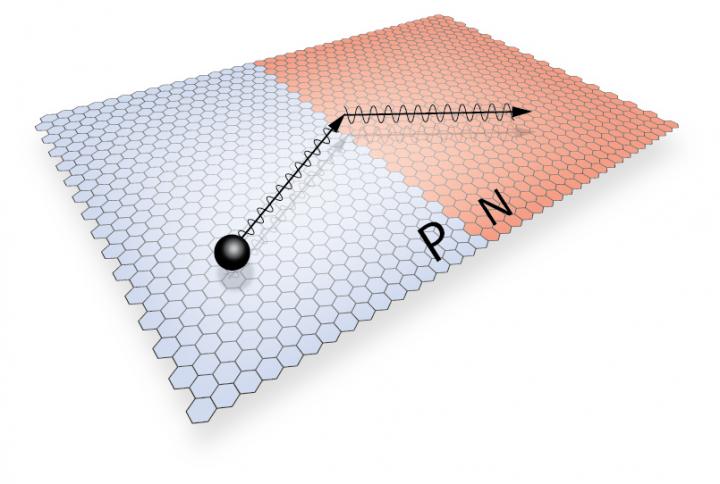Just when you thought graphene couldn't get any more awesome, physicists have for the first time spotted electrons in this atomically-thin material behaving like particles of light… only better.
This strange behaviour was first predicted in 2007, but has never been reproduced experimentally until now - and the phenomenon could lead to a whole new way of making super-efficient electronics.
In the new study, the electrons displayed negative refraction - which means they'd changed their path as they crossed a boundary between two regions of graphene. That meant they could be manipulated in graphene using optical devices like lenses and prisms.
"The ability to manipulate electrons in a conducting material like light rays opens up entirely new ways of thinking about electronics," said lead researcher Cory Dean from Columbia University.
"For example, the switches that make up computer chips operate by turning the entire device on or off, and this consumes significant power," he adds.
"Using lensing to steer an electron 'beam' between electrodes could be dramatically more efficient, solving one of the critical bottlenecks to achieving faster and more energy efficient electronics."
Graphene, among many of its other awesome properties, is famous for being an incredible conductor, capable of letting electrons whizz through its carbon structure at high speeds.
At these high speeds, electrons can travel in straight lines without scattering - just like light rays - and optics-like properties can begin to emerge.
One the most famous of light's properties is that it changes direction - or refracts - when it passes from one material to another. That's the reason your legs look all weird and wobbly when they're underwater, and it's also why we can use lenses and prisms to focus and steer light.
Conventional materials such as glass have what's known as a positive index of refraction, which means they bend light in a way we'd expect. But it's also possible to create 'metamaterials' with a negative index of refraction, that bend light in the opposite way.
That can have all kinds of cool consequences, like allowing researchers to make objects invisible by bending light around them.
That negative refraction is what the team was looking for in electrons, and researchers back in the said one of the researchers, Avik Ghosh. had already shown that it was possible. In fact, it's way easier for electrons to do it than light.
While light requires special optical metamaterials to be engineered, electrons achieve negative refractions naturally across boundaries between two different types of conductors, known as p-n junctions.
The p (or positive part of the junction) refers to a hole-type conductor, and the n (the negative part of the junction) is an electron-type conductor. You can see the negative refraction happening below as an electron crosses the boundary of these two types of graphene:
 Cory Dean, Columbia University
Cory Dean, Columbia University
In the past, researchers have only been able to achieve this negative refraction of electrons in weird materials at super-cold temperatures - which isn't very useful for modern electronics.
Now, the team from Columbia University managed to do the same thing with graphene at room temperature, which means the optical properties of electrons just entered the 21st century.
It wasn't an easy path to get there, though. There were two big hurdles to overcome: first of all, they had to create super 'clean' graphene, with no flaws in its structure at all, to ensure that the electrons would travel in a straight line like rays of light, and not scatter.
They then had to map exactly how electrons cross the p-n junction in detail, so they could work out how to focus the electrons on the junction in just the right way to achieve negative refraction.
They were finally able to do that using magnetic fields as a type of lens that focussed the electrons at the graphene p-n junction, and saw them bend across it - confirming for the first time a behaviour that was predicted almost a decade ago.
There's still a long way to go before we see this ability being used in electronics, but it could be the key to unlocking the true potential of graphene - the material is already a great conductor of electrons, but its downfall is that it's so good, it's hard turn the electron stream off.
The team will now look into whether they can use this light-like property of electrons to turn off a current more easily.
"If that works to our satisfaction, we'll have on our hands a low-power, ultra-high-speed switching device for both analog and digital electronics, potentially mitigating many of the challenges we face with the high energy cost and thermal budget of present day electronics," said one of the researchers, Avik Ghosh.
Watch this space.
The research has been published in Science.
